The 2015 MacBook Review
by Ryan Smith on April 14, 2015 10:15 AM ESTWindows Performance
Shifting gears from OS X, let’s take a look at performance under Windows. Though not every MacBook will be used with Windows, Windows gives us a wider selection of benchmarks to work with, and it gives us a chance to compare the MacBook to some contemporary PCs.
For our Windows comparison I’ve pulled in a number of results from our most recent Core M review, including other Core M laptops, the Haswell-U powered Surface Pro 3, and a couple of Broadwell-U powered laptops. Of particular interest is likely the Asus UX305, which is another Core M based laptop that uses a very similar build. At 13.3” it’s larger than the MacBook, but it is a similar aluminum fanless design.


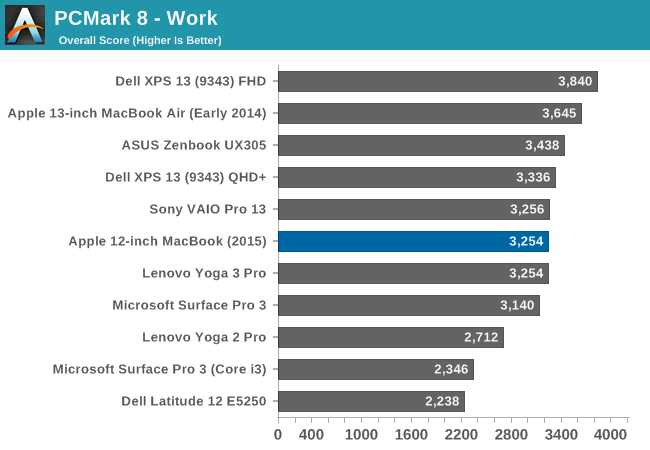
Depending on which sub-test we’re looking at, the PCMark workloads are a mix of bursty workloads, lightly threaded workloads, and heavily threaded workloads. As a result the MacBook and its Core M processor are given some opportunity to show off, and at other times is pushed back due to its cap on sustained performance.
The Home workload is one such light test, which plays into the MacBook’s favor. Here it’s towards the top of the charts, surpassing everything other than the Core M based Asus UX305, and then the more powerful Broadwell-U based Dell XPS 13s. I keep rattling on about workload types and this is a good example of why it matters, because in a light workload the MacBook is among the fastest of the ultra-portables, beating out many other Core M devices and also some Haswell based Ultrabooks. Put another way, in a light workload Core M can already deliver (and at times exceed) one-generation old Haswell Ultrabooks.
As for the Creative and Work workloads, the MacBook still places relatively well. Doing this well on the Creative workload was a bit of a surprise, since it’s the most demanding benchmark of the 3. I suspect we may be seeing a mix of dividends from the SSD and Core M’s GPU, Otherwise the lighter Work test actually has the MacBook farther behind the pack, with performance in-line with other Core M laptops, though not as exciting compared to the Ultrabooks.
Overall, between our OS X and Windows CPU benchmarks, what we’re finding is that the performance of the MacBook generally mirrors our expectations given what we know about its design and component selection. Given a light workload that allows the Core M CPU inside of the MacBook to turbo to its fastest speeds, it’s a very potent competitor in a small package, able to give all but the most recent Ultrabooks a run for their money. However heavier, sustained workloads drive a wider gap in between the two classes of devices, and in those cases the MacBook offers performance closer to Ultrabooks a 3-4 years old.
Shifting gears one more time, let’s take a look at GPU performance. GPU workloads present an interesting scenario for Core M, and by extension the MacBook. The underlying Intel HD Graphics 5300 GPU is a GT2 configuration, making it moderately powerful for an iGPU, however the power and thermal constrains on the MacBook means that the laptop doesn’t have the power required to run a GT2 GPU at full speed.
With the Broadwell CPU cores alone able to chew up 4.5W and then-some, a combined GPU+CPU workload will generally put the MacBook in a pinch. Consequently I don’t see the MacBook being used as any kind of gaming machine – the MacBook Air is undoubtedly a much stronger contender – but it’s useful to put this performance in context.
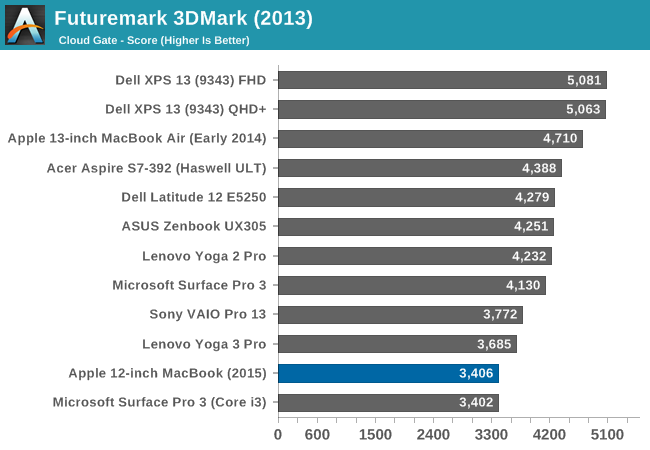
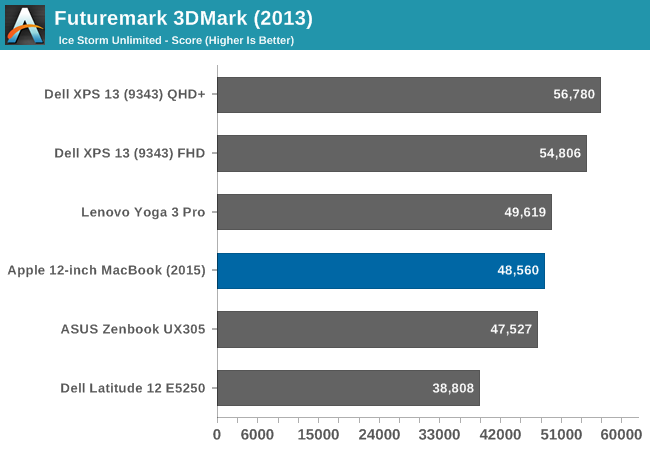
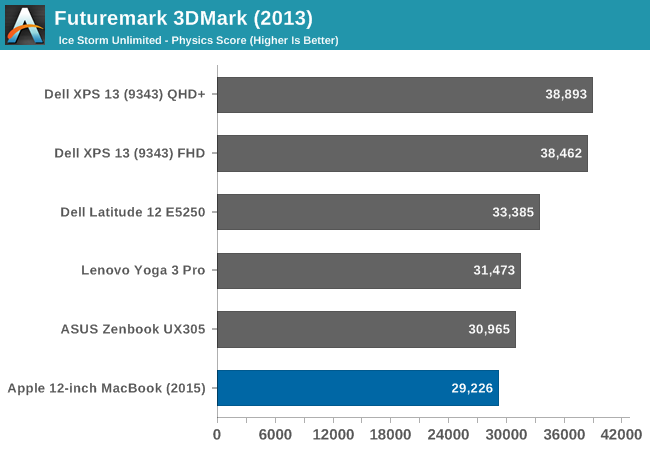
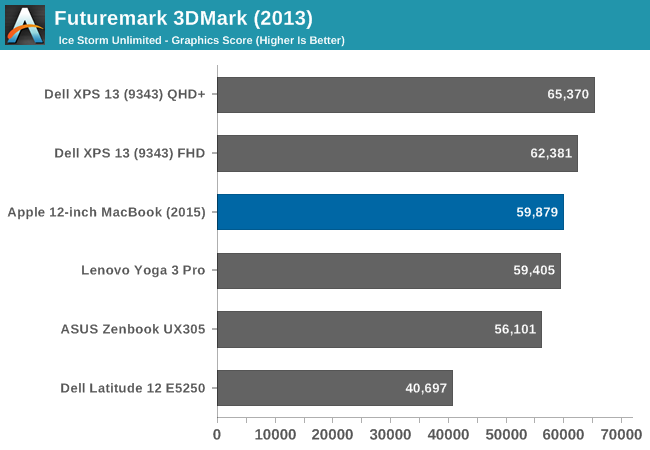
Our 3DMark scores handily illustrate this exact point. Facing significant power and thermal limits, the MacBook has to pull back in performance and consequently ends up near the bottom of our charts, versus its much better showing in PCMark. The 2014 MacBook Air 13” is some 38% faster at Cloud Gate, and on the newer Ice Storm benchmark the results aren’t much better. Of the two it’s worth noting that Cloud Gate is a much more complex and longer running benchmark, whereas Ice Storm is a quick running tablet-sized benchmark. Consequently Cloud Gate throttles harder and sooner, which is why the MacBook does relatively worse there. Overall the MacBook doesn’t even beat any of the other Core M laptops, which is a bit surprising. But nothing here is quite like the MacBook, so it’s somewhat different in its combination of small size and aluminum chassis.
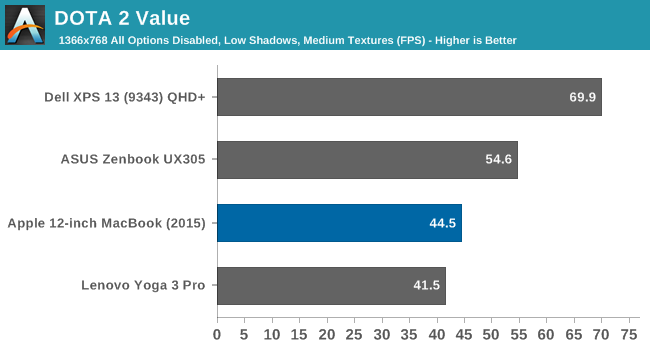
Meanwhile I have also run our DOTA 2 Value benchmark against our other Core M devices and the Broadwell-U based Dell XPS 13 for good measure. On an absolute basis 44.5fps is definitely playable for a game like DOTA, however on a relative basis this is a weaker showing than the UX305, not to mention the XPS 13. Compared to the UX305 the MacBook again appears to be throttling sooner and harder, whereas the Ultrabook-sized XPS takes full advantage of its higher power limits and better cooling.
Ultimately as we said when opening up our look at GPU performance, the MacBook’s GPU is potent on paper, but it simply doesn’t have the power and cooling capabilities needed to take full advantage of it. This means that while CPU performance isn’t too far removed from the Ultrabooks, GPU performance absolutely is.
Finally, I wanted to take one last look at performance relative to the tablets, this time from a GPU perspective.
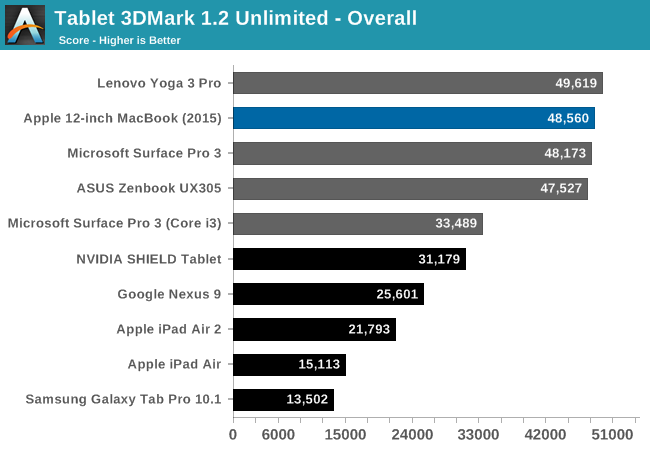
While the iPad Air 2 makes a good run on the MacBook in the web benchmarks, it and the other tablets are even more power limited than the MacBook, and as a result their GPU performance is even more constrained. The MacBook still has a better than 2x lead on the iPad Air 2 in this GPU benchmark, so judging from this it will be some time yet until an iPad's GPU performance catches up with this MacBook's.










354 Comments
View All Comments
BittenRottenApple - Wednesday, April 15, 2015 - link
Edit, please forgive the double post, thank you very much.sbuk - Thursday, April 23, 2015 - link
No. Not with rampant idiocy like yours.ppi - Wednesday, April 15, 2015 - link
While I am no lover of Apple (in fact, Apple products can't cross my door), you need to give credit where its due.1) That single port can serve (yes with dongle, but still) as single cable to plug you to power, ethernet, external display, keyboard and mouse. Now this is mucho better than my current Lenovo T-series, where I need to plug all those cables individually every time I change location.
2) 8 GB RAM and 256 GB SSD is insufficient? You came here back in time from 2045 or what? Show me notebook with better BASE specification.
3) If you are processing spreadsheets, that Core-M cannot handle, it must be quite a chore to do it on standard notebook as well. I would suggest optimizing the spreadsheet (less dynamic formulas where it is not necessary) or if it does not help, considering moving your work to SQL server.
smorebuds - Tuesday, April 14, 2015 - link
Name one Core M device that's in the netbook price range. The UX305 is probably the cheapest decent Core M laptop and it's $699 base price with 8gb ram and 256gb ssd. How does that equate to a netbook exactly?The logical successor to netbooks are the sub-$300 Windows/Chromebook Atom laptops. While they are certainly snappier than the old Atom netbooks, they are also unmistakably budget devices.
I have an HP Stream 13 and an UX305, and while I appreciate the $200 Stream for what it can do, it's nowhere near as responsive as the UX305 - aka NOT A NETBOOK.
smorebuds - Tuesday, April 14, 2015 - link
Ok do you consider every small laptop to be a netbook? I guess I assumed we were taking performance into account as well...MykeM - Tuesday, April 14, 2015 - link
Is a netbook equipped with a SSD that read/write in the 800/400 MB/s range? Not even the Dell XPS13 comes with such SSD.bobhays - Wednesday, April 15, 2015 - link
These arguments are so ignorant that I had to create an account so I could reply. The new MacBook IS a netbook. A netbook is a small, portable laptop that has enough processing power to do basic office tasks and browse the internet. EXACTLY what this laptop is designed for. A netbook is not defined by it's price range or quality, it is defined by it's purpose. If someone made a cheap, but exteremely well performing sports coupe, you are not going to say no that is not a sports car because it doesn't have the same quality as a ferrari. Just because the new MacBook is more expensive and has better specs (not necessarily performance) does not mean it serves another purpose. It does the same thing as a netbook (because it is one) for a different market. The only reason people are arguing right now over whether this is a netbook or not is because there were no premium netbooks before so everyone assumed a netbook means weak computers that lag behind. A netbook is essentially a low performance (and previously low priced) ultrabook and that is the perfect description for the new MacBook. Thanks for reading and if you disagree please make a point and not an ad hominem.zhenya00 - Wednesday, April 15, 2015 - link
I think you blur the lines too much. A netbook is exactly as its name implies - a device primarily designed to browse the Internet. The netbook has always been defined by a gimped operating system and/or (nearly always and) cheap construction in order to make it as affordable as possible.The MacBook is not a netbook.
- It has a full operating system, exactly the same as every other Mac computer.
- It has premium parts befitting the most expensive laptops on the market.
The ONLY thing you seem to be focusing on is the processor - there is nothing else in the MacBook design that could even remotely say 'netbook.' Is the 11" MBA a netbook? It's smaller and cheaper? Is a 2010 MBP a netbook? Because it has a slower processor than this MacBook.
The new MacBook is a laptop built on the premise that much modern computing does not need cutting edge CPU power, and can instead be built to prioritize things like battery life, silence, device size and weight. That doesn't make it a netbook.
BomC - Saturday, February 6, 2016 - link
Because of market saturation but also in acknowledgment of a widely diverse market, the industry is moving steadily away from default one-for-all solutions towards a far more diversified picture. In that sense, you might see this Macbook as an equivalent of the Galaxy View 18" tablet: purposely niche-oriented, experimental products in search of markets sectors for which they are suited. This is true for software as well. As a writer, I had to make do with a MS-Word-alike application for years; everyone's word processor was essentially the same Swiss army knife of an app. Nowadays I can use iA Write for distraction-free, concentrated writing, Mellel for academic pieces, Scrivener for writing setups and a whole host of apps for screenwriting. Can't speak for other people but I've never had it so good.Onionart - Wednesday, April 15, 2015 - link
Lenovo Yoga 3 Pro is also using Core M processor and as is many other ultrabooks in the market. This is the trend. Netbook is a name created for calling a specific class of computers. It is like calling all printers and scanners as xerox machines.....